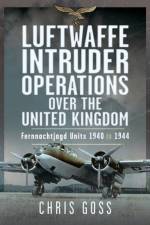- The Life of Maverick Ace Adrian Warburton, DSO, DFC, DFC (USA)
av Chris Goss
121
Adrian Warburton (known to all as Warby) was one of the most highly decorated pilots of the war. Fearless in the air, he won fame in Malta for his invaluable photo reconnaissance work at Taranto, Sicily and North Africa, So invaluable that he was ordered NOT to make detours to shoot down enemy planes, yet he shot down nine! A below-average misfit with 22 Squadron of Coastal Command Warby was sent to Malta to avoid trouble in the UK, and guided by an understanding Australian, quickly became famous. Known at first as a loner, he was given his head by AOC Air Vice Marshal Hugh Pughe Lloyd and the spectacular results he achieved enabled his unconventional behaviour to be over-looked. With his glamorous girl-friend Christina, the two became part of Malta's legend, symbols of the island's resistance. Still in Malta, Warby later became CO of first 69 Squadron and then 683 PR Squadron. After contributing greatly to the success of the Sicily landings, for which he was personally thanked by General Alexander, he commanded 336 PR Wing in North Africa. By then he was working closely with the Americans with whom he got on so well, as he did with the Canadians and South Africans. After a serious car accident, which caused him to be grounded, he returned to the UK and, thanks to his friendship with Elliott Roosevelt, the President's son, took up a liason job with the US PR Group at Mount Farm. On April 12, 1944 Warburton departed in an American aircraft on an unusual mission over Europe. Both plane and pilot disappeared without trace, giving rise to a host of rumours that his disappearance was intentional. Only now almost 60 years later, can the mystery be solved with the discovery of both aircraft and human remains near Munich in Germany. Based on interviews with nearly 150 of Warby's colleagues, and fully updated with recently unearthed information, Warburtons War paints a picture of a fascinating man, who over 350 operational missions from Malta alone became a living legend in that much bombed and beleaguered island.





























